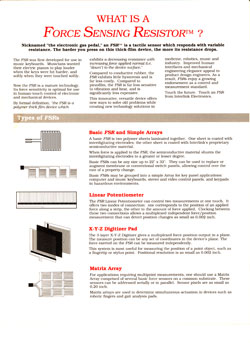 Interlink Electronics
WHAT IS A
FORCE SENSING RESISTOR?
Nicknamed "the electronic gas pedal," an FSR is a tactile sensor which responds with variable resistance. The harder you press on this thick-film device, the more its resistance drops.
The FSR was first developed for use in music keyboards. Musicians wanted their electric pianos to play louder when the keys were hit harder, and softly when they were touched softly.
Now the FSR is a mature technology. Its force sensitivity is optimal for use in human-touch control of electronic and mechanical devices.
By formal definition. "the FSR is a polymer thick film device which
exhibits a decreasing resistance with increasingforce applied normal (i.e. "down") to the device surface."
Compared to conductive rubber, the FSR exhibits little hysteresis and is far less costly. Compared to piezofilm, the FSR is far less sensitive to vibration and heat, and is significantly less expensive.
This innovative, versatile device offers new ways to solve old problems while creating new technology solutions in
medicine, robotics, music and industry. Improved human interfaces and mechanical engineering elegance appeal to product design engineers. As a result. FSRs enjoy a growing endorsement as a control and measurement standard.
Touch the future. Touch an FSR from Interlink Electronics.
Types of FSRs
Basic FSR and Simple Arrays
A basic FSR is two polymer sheets laminated together. One sheet is coated with interdigitating electrodes; the other sheet is coated with Interlink's proprietary semiconductive material.
When force is applied to the FSR, the semiconductive material shunts the interdigitating electrodes to a greater or lesser degree.
Basic FSRs can be any size up to 22" x 32". They can be used to replace or augment membrane or conventional switch panels, allowing control over the rate of a property change.
Basic FSRs may be grouped into a simple Array for key panel applications: computer and music keyboards, stereo and video control panels, and keypads in hazardous environments.
Linear Potentiometer
The FSR Linear Potentiometer can control two measurements at one touch. It offers two modes of connection: one corresponds to the position of an applied force along a strip, the other to the amount of force applied. Clocking between these two connections allows a multiplexed independent force/position measurement that can detect position changes as small as 0.002 inch.
X-Y-Z Digitizer Pad
The 3-layer X-Y-Z Digitizer gives a multiplexed force-position output in a plane. The measure position can be any set of coordinates in the device's plane. The force exerted on the FSR can be measured independently.
This system is most useful for measuring the position of a point object such as a fingertip or stylus point. Positional resolution is as small as 0.002 inch.
Matrix Array
For applications requiring multipoint measurements, one should use a Matrix Array comprised of several basic force sensors on a common substrate. These sensors can be addressed serially or in parallel. Sensor pixels are as small as 0.20 inch.
Matrix arrays are used to determine simultaneous actuation in devices such as robotic fingers and gait analysis pads. |
